Biology and Management of the Hessian Fly in the Southeast
ENTFACT-155: Biology and Management of the Hessian Fly in the Southeast | Download PDF
Kathy L. Flanders, Extension Specialist and Professor, Entomology and Plant Pathology, Auburn University
Dominic D. Reisig, Extension Specialist and Assistant Professor, Entomology, North Carolina State University
G. David Buntin, Professor, Entomology, University of Georgia
Matthew Winslow, Graduate Research Assistant, Virginia Polytechnic Institute and University
D. Ames Herbert Jr., Professor, Entomology, Virginia Polytechnic Institute and University
Douglas W. Johnson, Extension Professor of Entomology and IPM Coordinator, Entomology, University of Kentucky
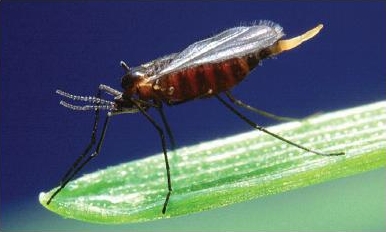
Figure 1. Hessian fly adult (Photo credit: Scott Bauer, USDA Agricultural Research Service, Bugwood.org)
Hessian fly, Mayetiola destructor (Say), is a serious pest of winter wheat in the southeastern United States. Severity of Hessian fly infestation varies from year to year and by location. Outbreaks of this insect have occurred periodically in the United States since its introduction the mid-1800s. The Hessian fly is believed to have been introduced into Long Island, New York, in straw bedding used by Hessian soldiers during the Revolutionary War. Hessian fly prefers to feed on wheat, but may also infest triticale, barley, and rye. Hessian fly does not attack oats or ryegrass. In the coming years, entomologists expect the risk of economic losses from Hessian fly to continue. Reasons for this include adoption of crop rotation schemes that lead to planting wheat in the same field in consecutive years, use of wheat as a cover crop, shifts to an earlier wheat planting date, and increased wheat acreage. Emergence of Hessian fly biotypes that overcome resistance in most wheat varieties has led to supply shortages of wheat varieties resistant to Hessian fly. This publication discusses the biology of the Hessian fly and provides suggestions for managing this insect.
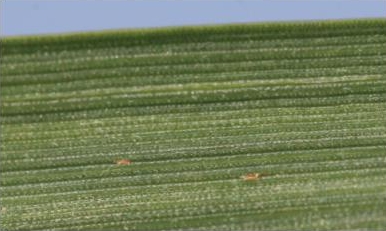
Figure 2. Hessian fly eggs on a leaf (Photo credit: Dominic Reisig)
Description and Life Cycle
The Hessian fly (Figure 1) is a small, mosquito-like fly, about 1/8-inch long. The female Hessian fly adult is reddish brown to black in color, whereas the slightly smaller males are brown or black. Many adult flies that resemble Hessian flies can be found in wheat fields. Hessian fly adults can sometimes be distinguished from other small flies of similar size by the presence of twelve to sixteen segmented bead-like (moniliform) antennae, black-colored wings, and legs as long as or longer than the body length. Adult females live 1 to 2 days and can lay two hundred fifty to three hundred small, elliptical, orange-colored eggs in grooves on the upper side of wheat leaves (Figure 2). Often Hessian flies begin depositing eggs soon after seedling emergence. Eggs are deposited singly or end to end in “egg lines” between the veins on the upper surface of the young leaves.
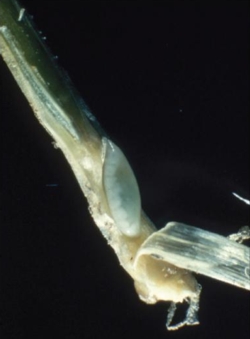
Figure 3. Hessian fly larva (Photo credit: USDA ARS)
The maggots (larvae) hatch from the eggs after 3 to 10 days and are orange-colored for 4 or 5 days before turning white (Figure 3). As larvae mature, a translucent green stripe appears down the middle of the back. The maggot is about ¼-inch long when fully grown. The last stage of the maggot is spent inside the flaxseed or puparium. The flaxseed is a shiny, brown protective case about 1/8-inch long (Figure 4). It is built from the insect’s skin and named for its resemblance to a seed from the flax plant. It is not uncommon to find Hessian fly maggots or flaxseeds stacked up one behind the other (Figure 5), particularly in heavy infestations. If weather conditions are favorable, the Hessian flies will pupate (transform into adults) inside the flaxseed. Adults then emerge and start a new generation. If it is too hot or cold, Hessian flies remain as maggots inside the flaxseed until the weather moderates.
There are three to six generations per year of this pest in the South, with fewer generations in northern latitudes. Generations tend to overlap. The entire life cycle requires about 35 days at 70 degrees F, but takes longer at cool temperatures because insects are cold-blooded. Maggots continue feeding as long as temperatures are above 40 degrees F and below 80 degrees F. The pest oversummers as flaxseeds in wheat stubble. The first generation develops during September or October, depending on latitude and is generally on found on volunteer wheat or wild grass hosts, the most important of which is little barley, Hordeum pusillum. There are often two more generations in the fall and early winter in Alabama and Georgia, but only one generation during the fall and winter in North Carolina. In late winter or spring, adults emerge and start a new generation when temperatures reach between 50 to 60 degrees F. There is usually one spring generation in northern Alabama, northern Georgia and North Carolina, but there may be two spring generations in southern Alabama and southern Georgia.
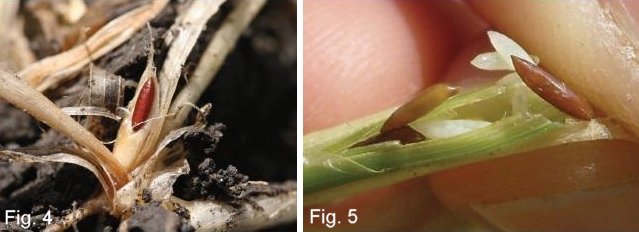
Figure 4. Hessian fly puparium (flaxseed) at the base of a wheat plant (Photo credit: Dominic Reisig)
Figure 5. In heavy infestations, many Hessian flies can be found behind a single leaf sheath. (Photo credit: Rudy Yates)
Newly hatched Hessian fly maggots migrate behind the leaf sheaths and move downward, ultimately locating below ground at the base of the small wheat plants, where they feed. The larvae can feed for 14 to 30 days, depending on temperature, and can injure the plants by rupturing leaf or stem cells. They also cause the plant to form an area of nutritive tissue around the base to enhance their feeding, which can result in tiller stunting and dieback. Plants infested with Hessian fly show various symptoms. Stunted or dead tillers (Figure 6), and thin wheat stands are typical signs of early season infestation (Figures 7 and 8). Stunted vegetative tillers are often dark green and sometimes have a blue tinge. Leaf blades on infested tillers are wider and shorter than normal, and leaf sheaths are shorter (Figure 9). If tillers that were infested when they were small survive and produce grain heads, the heads are small and the stems are stunted.

Figure 6. Dead and stunted tillers caused by an early infestation of Hessian fly
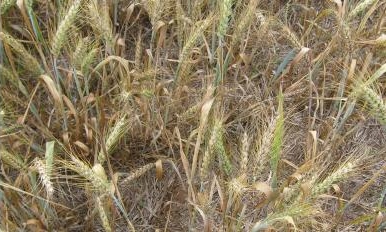
Figure 7. Thin stand and stunted plants resulting from a severe Hessian fly infestation

Figure 8. Thin stand and stunted plants resulting from a severe Hessian fly infestation
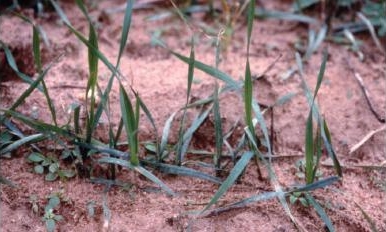
Figure 9. Wheat tillers that are infested early have shortened leaf sheaths
Hessian fly adults preferably lay eggs on the uppermost leaves. Therefore, as the plant grows, maggots will be found further up the plant, but always behind the leaf sheath just above a stem joint. A shorter distance between joints is a symptom of Hessian fly infestation. Tillers infested in spring when they are older may have weakened stems, small heads, and poorly filled grain heads with low-quality kernels. Often, wheat lodges in seriously infested fields.
A thin stand consisting of stunted wheat plants with few heads is the sign of an extremely heavy Hessian fly infestation that began when the plants were small. A moderate infestation may result in yield loss with less obvious symptoms. Yield loss is usually significant if more than 5 to 8 percent of tillers are infested in the early tiller stage. Late winter or early spring generations of Hessian fly can also cause considerable damage. In some areas, such as Kentucky, spring infestations of Hessian fly are more common than fall infestations. If tillers are infested in spring, yield losses can be expected if 15 to 20 percent of stems are infested with Hessian fly. Hessian fly reduces forage yield production of winter wheat, but does not greatly affect wheat forage quality.
Management Strategies
Resistant and Tolerant Varieties
Correct varietal selection is probably the most inexpensive and effective method of Hessian fly management. This resistance often works by causing cell death and fortification of the cell wall around the nutritive tissue where the Hessian fly feeds. Many wheat varieties are advertised as having Hessian fly resistance.
In most cases, resistance is based on a single gene present in the variety that must match a gene in the Hessian fly. Unfortunately, the Hessian fly can overcome host plant resistance mechanisms, resulting in the formation of new strains called biotypes. Plant breeders try to stay ahead of the biotypes by producing wheat varieties with different resistance genes. To be effective, wheat varieties must be specifically resistant to the local Hessian fly genotype. In addition to the information provided at the additional information link, growers can get information on Hessian-fly-resistant varieties from their local land-grant university. In most cases, varieties rated as having "good" resistance should provide enough protection to avoid economic losses due to Hessian fly. In areas with severe Hessian fly problems, the use of resistant and tolerant varieties may not be sufficient to prevent infestations from occurring.
Rotation
Although Hessian fly can become serious under other situations, the most serious infestations occur when wheat is planted early into wheat stubble or into fields next to wheat stubble, because the Hessian fly oversummers in wheat stubble. Crop rotations that prevent new wheat from being planted into or near a previous wheat crop’s stubble will reduce the chances of Hessian fly infestation. Continuous no-tillage wheat may result in severe problems with Hessian fly as well as Take-All Disease and should be avoided. The Hessian fly is a weak flier, so putting distance between the location of new wheat plantings and the previous season’s wheat fields will help prevent infestations.
Control Volunteer Wheat
Control of volunteer wheat well before planting is recommended because Hessian flies are attracted to volunteer wheat when they emerge in September. Additionally, this practice will reduce the probability of infestation by wheat curl mite, the vector of wheat streak mosaic virus. Wildlife plantings of wheat, which are often planted early, can be a source of Hessian flies.
Cover Crops
Serious Hessian fly infestations have occurred where wheat for grain was planted near early-planted wheat for cover or where early-planted wheat was present for wildlife. In cropping systems where cover crops are used, such as tobacco, strip-till cotton, or peanut production, the use of other small grains will reduce Hessian fly populations. Although Hessian fly can develop on grasses in more than seventeen genera, some are more favorable hosts for egg laying and development. Oats are not favorable for Hessian fly reproduction and do not serve as a nursery, making this grain preferable over wheat for cover cropping in areas where wheat for grain is also produced.
Tillage and Burning
No-till planted small grains tend to grow more slowly in the fall than those planted in conventionally tilled fields. Hessian fly seems to infest both no-till and conventional-till at the same rate. However, conventionally tilled wheat grows fast enough that it can usually produce new tillers faster than the fly maggots kill infected ones. Conversely, the slower growth in no-till plants cannot keep up with the maggot feeding, and the plants eventually die. Plowing or disking wheat stubble after harvest effectively kills the Hessian fly by burying the oversummering flaxseeds. Planting soybean no-till into wheat stubble enhances Hessian fly survival by preserving the site where puparia spend the summer.
Burning wheat straw will reduce oversummering puparia, but many puparia are found below the soil surface where they are unaffected by the burn. Therefore, burning is not as effective as disking and is not recommended as a management method. Additionally, burning wheat can predispose fields to increased incidence of lesser cornstalk borer infestation in double-cropped soybean.
Systemic Seed Treatments
When applied at the correct rates, use of systemic insecticidal seed treatments (neonicotinoid treatments) can reduce populations of Hessian flies in the first part of the growing season. Generally, the highest labeled rates of clothianidin, thiamethoxam, or imidacloprid provide fair to good control of Hessian fly. However, when Hessian fly abundance is high, the use of these seed treatments is not always effective. Seed treatments will not control the late winter and spring generations of Hessian fly. The lowest labeled rates of these seed treatments are designed for aphid control and are not effective against Hessian fly. Because seed treatments are expensive, they should be used only after careful consideration of current production economics.
Foliar Insecticides
Foliar pyrethroid insecticides applied shortly after wheat emerges (at or before the two- to three-leaf stage) have been effective to manage Hessian fly. If applied at the right time, a pyrethroid will kill the adult flies and may also kill freshly hatched larvae before they become embedded behind the leaf sheaths. At least three of the following conditions should be met before using a pyrethroid for early season Hessian fly control: 1) wheat has been planted in the same field, adjacent to, or close (within 400 yards) to the previous year’s crop, 2) a resistant wheat variety has not been planted, 3) the seeds were not treated with a neonicotinoid insecticide, 4) Hessian fly has caused yield losses on this farm or nearby in previous years or 5) Hessian fly eggs are present on the wheat leaves.
Fields that passed the winter with a significant Hessian fly infestation will also be attacked by the next generation of larvae re-cycling in the crop. Fields with low tiller counts should be examined in January or February for Hessian fly before making the customary nitrogen applications in late winter. To judge the need for a pyrethroid treatment, examine the plants for flaxseeds to identify fields that will have high fly numbers. Squeeze some flaxseeds and see if the resulting fluids are white and milky (still larvae or early pupae) or reddish and relatively dry (adults about to emerge). Later scouting should focus on heavily infested fields for eggs on the top surface of new leaves. Eggs are very small, about 1/32 inch long, and magnification may be needed. An experienced person with good eyesight can detect Hessian fly eggs, especially in direct sunlight because the eggs will shine. Egg counts of four or more per leaf may justify a pyrethroid application. Tillers, especially dead tillers and stunted tillers, should be examined by peeling the leaf sheaths back carefully to look for Hessian fly maggots or pupae. If 20 percent of the tillers are infested with Hessian fly maggots or pupae at this time, significant yield losses can be expected and the money spent on nitrogen may not produce the desired yield response. If a pyrethroid is applied as the flies emerge and lay eggs some control may be accomplished. This spring rescue treatment is rarely effective, and when it is, it is generally only effective in high-pressure situations.
Delayed Planting
Growers are advised to plant during the planting dates recommended for wheat in their state. Planting before these dates increases the risk of Hessian fly infestation and diseases, such as barley yellow dwarf and wheat streak mosaic. Planting after these dates usually results in reduced yield potential. Because freezing temperatures kill Hessian fly adults, a traditional method for preventing Hessian fly infestation is to delay planting until after the first freeze (often called the fly-free date). Historically, the Hessian fly-free date was reported to be October 9 in the latitude of northern Kentucky, October 16 in the latitude of northern Tennessee, and October 23 to 27 in northern Georgia, southern Tennessee, and northern Alabama. This concept has not worked well further south or in Virginia and North and South Carolina because an early freeze is not a dependable event. Indeed, a killing freeze may not occur until December, long after the recommended planting date for wheat. Even in areas such as Kentucky, growers are advised to look at the 30- to 60-day weather outlook and delay planting further if warmer than normal temperatures are predicted.
Postharvest Practices that Spread Hessian Fly
Hessian fly pupae can survive the process of straw harvest. Therefore Hessian flies can be moved to new locations where that straw is used. This can increase the speed at which new biotypes of Hessian fly are disseminated.
Summary of Hessian Fly Management Practices
For a management program to be most effective, growers must implement a combination of the techniques mentioned above, preferably in coordination with neighboring producers. The efforts of a producer who rotates his or her wheat may be frustrated by a neighbor who plants wheat as a cover crop or who has a no-till, double-crop soybean field adjacent to his or her farm. One or a combination of these management strategies will minimize Hessian fly damage:
- Select a Hessian-fly-resistant variety.
- For grazing or cover cropping, plant oats or some other crop that is not a host for Hessian fly.
- If possible, use a tillage method that will bury wheat debris.
- Control volunteer wheat.
- Do not use susceptible wheat for wildlife plantings.
- Avoid planting into or near old wheat stubble.
- Do not plant wheat before the recommended planting date for your area. If possible, plant after the first frost.
- Consider using a systemic seed treatment if a susceptible wheat variety is grown.
- Consider an early season foliar insecticide if three of the five conditions mentioned above are true.
Issued: 7/14
Originally issued on 1/13 by Alabama A&M and Auburn Universities.
CAUTION! Pesticide recommendations in this publication are registered for use in Kentucky, USA ONLY! The use of some products may not be legal in your state or country. Please check with your local county agent or regulatory official before using any pesticide mentioned in this publication.
Of course, ALWAYS READ AND FOLLOW LABEL DIRECTIONS FOR SAFE USE OF ANY PESTICIDE!
Images: as credited
